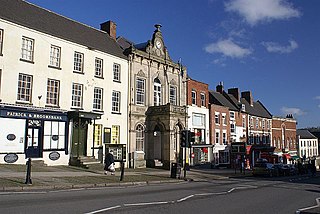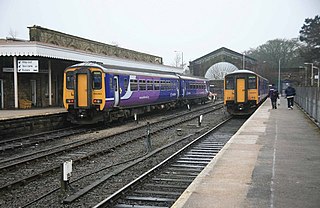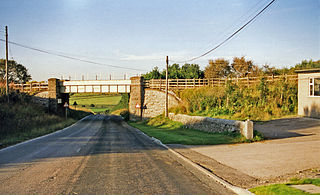Related Research Articles

Ashbourne is a market town in the Derbyshire Dales, England, with a population of 7,112 in the 2011 census. It contains many historical buildings and independently owned shops, and offers a historic annual Shrovetide football match. Its position near the southern edge of the Peak District makes it the closest town to Dovedale, to which it is sometimes referred as the gateway.

The Cromford and High Peak Railway (C&HPR) in Derbyshire, England, was completed in 1831, to carry minerals and goods between the Cromford Canal wharf at High Peak Junction and the Peak Forest Canal at Whaley Bridge. It dealt with the hilly rural terrain by using a number of inclines. It was closed by 1967, and the majority of the route, between Dowlow and Cromford, has become the High Peak Trail, a route on the National Cycle Network.

The Tissington Trail is a bridleway, footpath and cycleway in Derbyshire, England, along part of the trackbed of the former railway line connecting Ashbourne to Buxton. It takes its name from the village of Tissington, which it skirts. Opened in 1971, and now a part of the National Cycle Network, it stretches for 13 miles (21 km) from Parsley Hay (53.1706°N 1.7828°W) in the north to Ashbourne (53.0196°N 1.7397°W) in the south.

Buxton railway station serves the town of Buxton in Derbyshire, England. It is managed and served by Northern. The station is 25 3⁄4 miles (41.4 km) south east of Manchester Piccadilly and is the terminus of the Buxton Line.

The Buxton line is a railway line in Northern England, connecting Manchester with Buxton in Derbyshire. Passenger services on the line are currently operated by Northern Trains.

Parsley Hay railway station served Parsley Hay, a hamlet about 9.3 miles (15 km) south east of Buxton, Derbyshire, on the LNWR line to Ashbourne. The nearest large settlement is the village of Hartington.
The Ashbourne line was a 33 1⁄2 mi (53.9 km) railway from Buxton via Ashbourne to Uttoxeter. It was built by the London and North Western Railway using a section of the Cromford and High Peak Railway (C&HPR) and it joined the North Staffordshire Railway at Ashbourne, proceeding to Uttoxeter with a junction onto the main line at Rocester.

Higher Buxton railway station was opened in 1894 to the south east of Buxton, Derbyshire, on the LNWR line to Ashbourne and the south.

Hindlow railway station was opened for goods in 1833 near to Hindlow near King Sterndale to the south east of Buxton, Derbyshire on the Cromford and High Peak Railway and the LNWR line to Ashbourne and the south.

Dowlow Halt was opened in 1920 between Dowlow and Greatlow to the south east of Buxton, Derbyshire on the London and North Western Railway line to Ashbourne and the south.
Hurdlow railway station was near to the hamlet of Hurdlow to the south east of Buxton, Derbyshire on the LNWR line to Ashbourne and the south.

Clifton (Mayfield) railway station was opened on 3 May 1852 by the North Staffordshire Railway at Clifton on the southern fringes of Ashbourne, Derbyshire. Originally named Clifton, it was renamed Clifton (Mayfield) on 22 August 1893, and was known as Clifton for Mayfield in some timetables.

Rocester railway station was a railway station built by the North Staffordshire Railway (NSR) located at Rocester in Staffordshire.
Thorpe Cloud railway station was opened in 1899 between the villages of Thorpe and Fenny Bentley in Derbyshire, south east of Buxton.

Tissington railway station is a disused British railway station near Tissington, a village in Derbyshire near Ashbourne. It opened on 4 August 1899 and closed on 7 October 1963.

Alsop en le Dale railway station was opened in 1899 near Alsop en le Dale and Alstonefield, villages in Derbyshire southeast of Buxton.

Hartington railway station opened in 1899 about two miles away from the village it served - Hartington in Derbyshire, south east of Buxton.

Norbury is a village in Derbyshire, England. It is located 3 miles (4.8 km) north of Rocester, on the B5033 road and the River Dove. The hamlet has links with George Eliot's family, the Evans. George Eliot's father, Robert Evans, was born in Roston Common and sang in the choir at Norbury church, and most of George Eliot's paternal ancestors are buried there.

Ashbourne railway station formerly served the town of Ashbourne in Derbyshire. There have been two stations in the town. The first, opened in 1852, was operated by the North Staffordshire Railway (NSR); it was replaced in 1899 by a station at a new location, jointly operated by the NSR and the London and North Western Railway (LNWR). In 1923 the station passed into the ownership of the London, Midland and Scottish Railway and in 1948 that of the London Midland Region of British Railways. It was finally closed to all traffic in 1963.
Dowlow Works is a quarry in High Peak, Derbyshire near the village of Earl Sterndale. The works also are situated close to the former Ashbourne Line and Cromford and High Peak Railway, which were closed in the 1950s and 1960s. There was once passenger and workmans trains that stopped at Dowlow Halt but in the 21st century, only a stub of the line from Buxton to Hurdlow remains in use. The rest of the line is now the High Peak Trail.
References
Coordinates: 52°58′40″N1°49′07″W / 52.9779°N 1.8187°W
| This article on a railway station in the East Midlands is a stub. You can help Wikipedia by expanding it. |